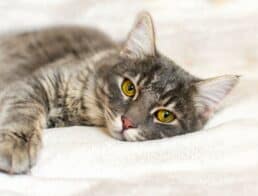Question: What can I give my cat for hairballs?
Cat has a severe hairball problem. My question is in the old days we used to give them mineral oil. Is there anything we can do to help her pass them any easier?
–Edward
Answer:
Dear Edward,
Thanks for writing in about your cat’s hairball troubles. I bet most cat owners have had the same question at one time or another. We have some good options to help cats with hairballs, but first, let’s talk about why they get them in the first place.
A hairball, or trichobezoar, is a mass of the cat’s own hair seen when it’s passed in vomit or stool. Many cats vomit or defecate the occasional hairball but when it happens several times a month, there may be a more serious problem at play.
Why Do Cats Get Hairballs?
A cat’s digestive tract is designed to deal with a fair amount of ingested hair. After all, cats are known for impeccable grooming habits which necessarily cause them to swallow their own hair. They’re also carnivorous animals who prefer to eat furry rodents and feathery birds.
So why do cats develop problems with passing hairballs? One factor may be the lack of moisture present in dry kibble diets. The moisture level in dry cat food is much, much lower than the moisture in freshly killed rodents and birds. Even drinking water can’t make up for the difference.
Another more serious problem is inflammation in the GI tract. Low-grade bowel inflammation is common in house cats with chronic vomiting (Norsworthy, Estep, Hollinger, Steiner, Lavallee, Gassler, … & Kiupel, 2015).
When the supple tissue of the stomach and intestines becomes inflamed, it can’t move normally. This leads to the slow passage of ingested food and fur through the GI tract, drying the contents even more. Fur and bits of food form into a dry mat that gets stuck.
Your veterinarian is the best resource for diagnosing bowel problems in your cat. Take your cat for a check-up and discuss the next steps to find the root problem. This approach will help your cat a lot more than giving oral lubricants to help hairballs pass while ignoring the ticking time bomb of bowel disease.
Home Solutions for Mild Hairball Problems
For cats who are on the younger end of the age spectrum and otherwise healthy, it’s reasonable to try some simple interventions at home.
- Hypoallergenic diet– use a hypoallergenic diet exclusively for at least two months. Don’t give any other food sources for this time period so you can see if there is an improvement in the severity of the hairball problem. Your vet can write a prescription for the best hypoallergenic foods available.
- Moist food– even if you decide not to use a hypoallergenic food, you can still try an all canned or moist food diet. Make any diet changes gradually over a period of at least 7 days to avoid digestive upset.
- Probiotic– my preference is Proviable DC. Follow the directions on the package and use for at least 1 month to help balance your cat’s gut flora.
- Hairball remedy– most come in a gel or paste form. They’re made from petroleum jelly with flavoring added. We don’t recommend mineral oil anymore because cats can easily breathe it into their lungs. Hairball remedies should be considered for short-term use only, not a long-term solution.
If your cat is losing weight or has a poor appetite, don’t experiment with these recommendations. Instead, see your vet right away to get more targeted help for your cat.
Summary
Cat owners have come to think that vomiting of hairballs is normal. Chronic vomiting of hairballs (or anything else) is not normal, especially if it happens more than once a month. Cats with hairball problems may be suffering more than you realize. Get help from your veterinarian and your cat will thank you!
Sincerely,
TB Thompson DVM
Disclaimer: Your use of the Ask The Vet feature is subject to the Ask The Vet Terms of Use. Content is for informational and educational use only and should not replace professional veterinary advice.
References
Norsworthy, G. D., Estep, J. S., Hollinger, C., Steiner, J. M., Lavallee, J. O., Gassler, L. N., … & Kiupel, M. (2015). Prevalence and underlying causes of histologic abnormalities in cats suspected to have chronic small bowel disease: 300 cases (2008–2013). Journal of the American Veterinary Medical Association, 247(6), 629-635.
Disclaimer: Content is for informational and educational use only and should not replace professional veterinary advice.
































